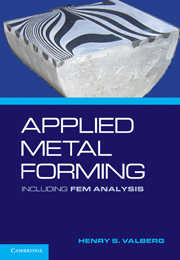Book contents
- Frontmatter
- Contents
- Preface
- APPLIED METAL FORMING
- 1 Characteristics of Metal Forming
- 2 Important Metal Forming Processes
- 3 FEA of Metal Forming
- 4 Theory
- 5 Reduction and Proportions of the Plastic Zone
- 6 Deformations from the Velocity Field
- 7 Technological Tests and Physical Simulation
- 8 Flow Stress Data
- 9 Formability and Workability
- 10 Friction and Friction Models
- 11 Thermal Effects
- 12 Experimental Metal Flow Analysis
- 13 Theoretical Methods of Analysis
- 14 Finite Element Analysis
- 15 FEA of Technological Tests
- 16 Forging
- 17 FEA of Forging
- 18 Extrusion
- 19 FEA of Extrusion
- 20 Rolling
- 21 FEA of Rolling
- 22 Drawing of Wire, Profiles, and Tubes
- 23 FEA of Wiredrawing
- 24 Sheet-Metal Forming
- Index
- References
4 - Theory
Published online by Cambridge University Press: 05 June 2012
- Frontmatter
- Contents
- Preface
- APPLIED METAL FORMING
- 1 Characteristics of Metal Forming
- 2 Important Metal Forming Processes
- 3 FEA of Metal Forming
- 4 Theory
- 5 Reduction and Proportions of the Plastic Zone
- 6 Deformations from the Velocity Field
- 7 Technological Tests and Physical Simulation
- 8 Flow Stress Data
- 9 Formability and Workability
- 10 Friction and Friction Models
- 11 Thermal Effects
- 12 Experimental Metal Flow Analysis
- 13 Theoretical Methods of Analysis
- 14 Finite Element Analysis
- 15 FEA of Technological Tests
- 16 Forging
- 17 FEA of Forging
- 18 Extrusion
- 19 FEA of Extrusion
- 20 Rolling
- 21 FEA of Rolling
- 22 Drawing of Wire, Profiles, and Tubes
- 23 FEA of Wiredrawing
- 24 Sheet-Metal Forming
- Index
- References
Summary
Because metal forming produces elastic and plastic deformations in the workpiece material and elastic deformations in the dies, an in-depth study of the metal forming process will require the determination of stresses and strains in the workpiece and the tooling. In addition, one needs to know some basic topics from the theory of elasticity and plasticity. In this chapter, a short introduction to this theory is therefore given. Because of the rather shallow treatment here, readers who are unfamiliar with this theory are referred to other textbooks for a more profound study.
Stresses
During metal forming the workpiece is deformed plastically by forces transferred from the die to the workpiece. A successful forming operation requires that there be plastic deformations in the workpiece, so that it changes shape permanently and conforms to the geometry of the die, while the die remains in the elastic state. If the die material becomes plasticized, the situation is one of overloading of the tooling, and the die geometry will gradually change because of the excessive forming loads. This means that the correct geometry of the formed component no longer can be maintained, so to continue appropriate metal forming, the dies must be replaced by new dies that can work the material while remaining in the elastic state.
The Stress Concept
Stress is defined as force per unit of area and refers to a particular point in a material.
- Type
- Chapter
- Information
- Applied Metal FormingIncluding FEM Analysis, pp. 53 - 76Publisher: Cambridge University PressPrint publication year: 2010
References
- 1
- Cited by



